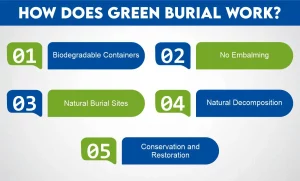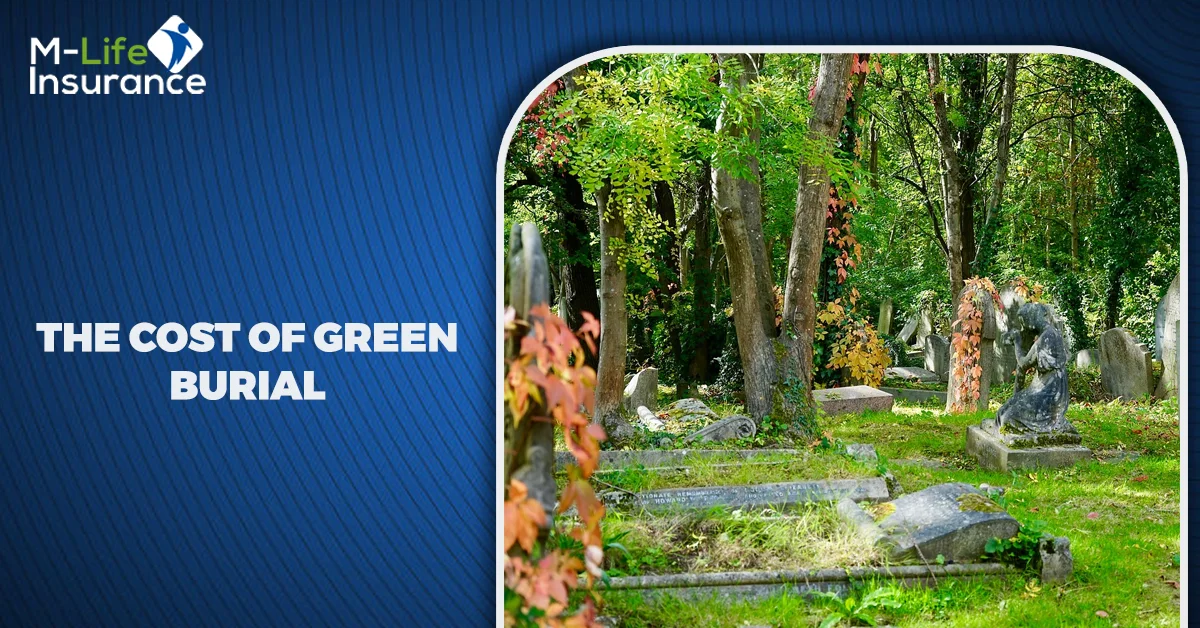In the symphony of life, the final notes we leave echo not just in memory but in the legacy we leave behind. Imagine a resting place that embraces the whispers of nature, where the gentle rustle of leaves becomes a memorial symphony, and every bloom is a tribute. Green burial; a serene, eco-conscious departure from the traditional—offers a harmonious blend of saying goodbye and giving back. It’s a poetic return to the earth, where simplicity meets sustainability in the tender embrace of the land.In this guide of green burial cost, we will explore the gentle footprint left by those seeking an environmentally friendly farewell. From understanding the concept to weighing the financial aspects, we unravel the threads of this heartfelt choice and the impact it can have on our planet. Join us as we navigate the lush pathways of green burials and delve into the harmony between cost, conscience, and the circle of life.
Please note that these costs are estimates and can significantly vary based on geographic location, cemetery policies, and specific choices made by the individual or family. Additionally, some conservation burial grounds may have membership fees or additional requirements that can affect the overall cost.
What is a Green Burial?
A green burial, also known as a natural burial, represents an environmentally conscious approach to the final resting place of a deceased person. Unlike traditional burials that involve embalming fluids, non-biodegradable caskets, and concrete vaults, green burials focus on returning the body to the earth in a way that minimizes environmental impact.In a green burial, the body is interred without the use of chemicals or materials that hinder natural decomposition. Biodegradable coffins, shrouds made of natural fibers, or simply being laid to rest directly in the earth are common practices. The aim is to facilitate the body’s natural decomposition process, allowing it to return to the soil and contribute to the ecosystem’s regeneration.
How Does Green Burial Work?
Green burial operates on the fundamental principle of returning the deceased to the earth in a way that minimizes environmental impact and promotes natural decomposition. The process involves several key elements:1- Biodegradable Containers
Instead of traditional caskets made of non-biodegradable materials, green burials employ biodegradable coffins, shrouds made from natural fibers like cotton or linen, or simply wrapping the deceased in a biodegradable cloth.2- No Embalming
Embalming, a common practice in traditional burials, involves using chemicals to preserve the body. In green burials, embalming is avoided or limited, allowing the body to decompose naturally.3- Natural Burial Sites
Green burials usually occur in designated natural cemeteries or conservation burial grounds. These sites are specifically designed to have minimal environmental impact and often incorporate native plants or trees to mark graves instead of traditional headstones.4- Natural Decomposition
The body is laid to rest directly in the earth, promoting natural decomposition. As the body breaks down, it returns valuable nutrients to the soil, fostering the growth of vegetation and supporting the surrounding ecosystem.5- Conservation and Restoration
Green burial sites may contribute to the conservation of natural habitats or restoration of degraded landscapes, serving as sanctuaries for wildlife and native flora.How Much Does a Green Burial Cost?
One of the key considerations for many individuals exploring green burials is the cost involved. On average, the cost of a green burial varies significantly based on location, cemetery fees, the type of biodegradable casket or shroud chosen, and additional services.While green burial cost can vary based on different aspects, here is an approximate breakdown of expenses:| Expense | Cost Range |
| Green Burial Plot | $800 – $4,000 |
| Biodegradable Coffin or Shroud | $200 – $2,500 |
| Cemetery Fees | $500 – $3,000 (per plot) |
| Transportation of the Body | $200 – $500 |
| Grave Opening and Closing | $500 – $1,500 |
| Optional Services (flowers, etc.) | $100 – $500 |
| Total | $2,300 – $12,000 |
What are the Pros and Cons of a Green Burial?
Here are the pros and cons associated with green burials:Pros of Green Burials
- Environmentally Friendly: Green burials significantly reduce the ecological footprint associated with traditional burial methods. They minimize the use of chemicals and non-biodegradable materials, preserving natural resources and promoting soil health.
- Cost-Effective: In comparison to conventional burials that involve expensive caskets, embalming, and vaults, green burials can be more affordable. Opting for biodegradable materials and simpler ceremonies often results in lower costs.
- Conservation and Restoration: Green burial sites are often designed to serve as conservation areas or natural preserves. They contribute to the restoration of habitats, fostering biodiversity and preserving natural landscapes.
- Personal and Meaningful: Many individuals find green burials to be more personal and emotionally meaningful. Being laid to rest in a natural setting connects the deceased with the environment, providing a serene and peaceful final resting place.
Cons of Green Burials
- Limited Availability: Green burial sites might not be as widespread as traditional cemeteries, limiting options for those seeking such environmentally conscious interments.
- Regulatory Challenges: Some regions lack specific regulations or guidelines for green burials, leading to uncertainty or limitations in implementing this practice.
- Cultural and Religious Restrictions: Green burials might not align with certain religious or cultural practices, limiting the options for individuals from specific backgrounds.
- Potential Maintenance Issues: Natural burial sites may require ongoing maintenance to preserve the environment, potentially posing challenges for their long-term sustainability.
Green Burial Cost vs. Cremation
Comparing the costs of a green burial with cremation can be multifaceted and may vary based on several factors. Here’s an overview:Cost Comparison: Green Burial vs. Cremation
Green Burial | Cremation | |
| Cost Range | Approximately $2,300 to $12,000 (variable based on location, cemetery fees, and chosen services). | Usually ranges from $1,000 to $4,000, depending on the chosen services and location. |
| Expense | Include plot fees, biodegradable coffin or shroud, cemetery fees, transportation, grave opening and closing, and optional services. | Includes cremation process, urn, crematory fees, transportation, and optional services (memorial ceremony, urns, etc.). |
Factors Affecting Costs
| Location | Costs can significantly vary based on the region or city. Urban areas might have higher prices compared to rural settings. |
| Services Chosen | Both green burials and cremations offer various service options. Additional services, such as memorial ceremonies, urns, or transportation, can impact the overall cost. |
| Cemetery Fees | This fee can fluctuate based on the chosen location and the specific services offered by the cemetery or crematory. |
| Urn or Biodegradable Container: | The cost of an urn for cremated remains versus a biodegradable coffin or shroud for a green burial can differ significantly. |
Comparison Between Green Burial Cost and Direct Burial Cost
Comparing the costs of a green burial and a direct burial can provide insights into their financial differences:Green Burial Cost | Direct Burial Cost | |
| Cost Range | Approximately $2,300 to $12,000, depending on various factors such as location, cemetery fees, chosen services, and biodegradable materials used. | Generally ranges from $1,500 to $4,000, but prices can vary significantly based on the location, chosen services, and cemetery fees. |
| Expense | Include plot fees, biodegradable coffin or shroud, cemetery fees, transportation, grave opening and closing, and optional services. | Typically cover basic services, including minimal preparation of the body, transportation, grave site, and necessary documentation. |
Factors Impacting Costs:
| Service Components | Green burials often involve more environmentally friendly practices, utilizing biodegradable materials and specific burial grounds, which might contribute to higher costs compared to the simpler approach of direct burials. |
| Cemetery Fees | Direct burials might sometimes occur in standard cemeteries with lower plot fees and fewer requirements, affecting the overall cost compared to specialized green burial sites. |
| Transportation and Optional Services | Both green burials and direct burials may have differing costs based on the level of transportation required and additional services chosen by the family, impacting the final expenses. |
Should People Invest in Green Burial?
The decision to invest in a green burial is a deeply personal one, influenced by various factors encompassing environmental, financial, emotional, and cultural considerations. Here are key points to contemplate when evaluating whether to opt for a green burial:Environmental Impact
- Sustainability: Green burials significantly reduce the ecological footprint compared to traditional burials. Choosing this option can contribute positively to environmental conservation and soil health.
- Connection to Nature: It offers a harmonious return to the earth, fostering a connection with the natural world and leaving a lasting legacy of environmental stewardship.
Financial Considerations
- Cost-Efficiency: While costs might vary, green burials can sometimes be cost-competitive or slightly higher than traditional methods. Opting for simpler, biodegradable materials and services may lead to lower expenses.
- Long-Term Savings: Some might view the investment in a green burial as a long-term savings plan, considering the potential preservation and sustainability of the burial site.
Personal and Emotional Factors
- Meaningful Farewell: Green burials offer a serene and natural resting place that resonates emotionally with many, providing a tranquil and environmentally conscious final farewell.
- Legacy and Values: For individuals passionate about environmental sustainability, a green burial can reflect personal values and leave a legacy aligned with these beliefs.
Cultural and Practical Considerations
- Cultural Relevance: Consider whether a green burial aligns with religious or cultural beliefs. Some traditions may support or restrict certain burial practices.
- Availability and Accessibility: Assess the availability of green burial sites in your area and whether they meet your preferences and requirements.
Frequently Asked Questions (FAQs)
1- Are Green Burials Expensive?
The perception of expense can vary among individuals. While some might consider green burials to be costly due to the additional expenses compared to direct burials, others perceive them as cost-effective considering the environmental benefits and overall impact.2- Is Green Burial Legal?
Green burials are legal in most areas, although regulations regarding the specifics might differ. It’s crucial to check local laws and cemetery guidelines before opting for a green burial.3- Is Green Burial Cheaper than Cremation?
The cost comparison between green burials and cremation varies and largely depends on the specific choices made by the individual or their family. While green burials can sometimes be in a similar price range as cremation, the environmental and personal considerations often play a significant role in decision-making.


